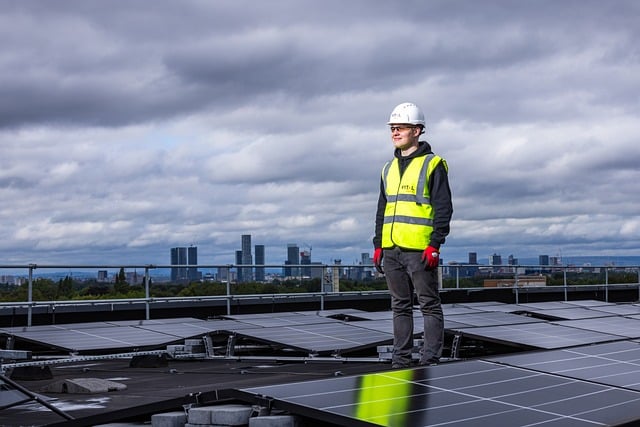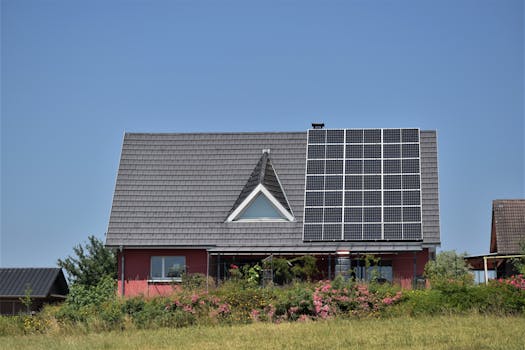“Empower Your Savings: Smart Budgeting for Your New Solar Inverter!”
Budgeting for a new solar inverter is a crucial step in maximizing the efficiency and cost-effectiveness of your solar energy system. A solar inverter converts the direct current (DC) generated by solar panels into alternating current (AC) for use in your home or business. When planning your budget, consider factors such as the type of inverter needed, installation costs, potential incentives or rebates, and long-term savings on energy bills. By carefully assessing these elements, you can make informed decisions that align with your financial goals while contributing to a more sustainable energy future.
Understanding Solar Inverter Costs
When considering the transition to solar energy, one of the most critical components to evaluate is the solar inverter. Understanding the costs associated with solar inverters is essential for effective budgeting, as these devices play a pivotal role in converting the direct current (DC) generated by solar panels into alternating current (AC) that can be used in homes and businesses. The price of a solar inverter can vary significantly based on several factors, including the type of inverter, its capacity, and the specific features it offers.
To begin with, it is important to recognize the different types of solar inverters available on the market. The three primary types are string inverters, microinverters, and power optimizers. String inverters are the most common and typically the most affordable option, making them a popular choice for residential installations. However, they may not be the best fit for every situation, particularly in homes with shading issues or complex roof layouts. On the other hand, microinverters, which are installed on each individual solar panel, tend to be more expensive but offer enhanced performance and monitoring capabilities. Power optimizers, while also more costly than string inverters, provide a middle ground by optimizing the output of each panel while still using a central inverter. Understanding these distinctions is crucial, as the type of inverter selected will directly impact the overall cost of the solar system.
In addition to the type of inverter, the capacity of the inverter is another significant factor influencing its price. Inverters are rated by their power output, typically measured in kilowatts (kW). A higher capacity inverter can handle more solar panels and, consequently, more energy production. While it may be tempting to opt for a lower-capacity inverter to save on initial costs, it is essential to consider the long-term implications. An undersized inverter may limit the system’s efficiency and overall energy production, potentially leading to higher electricity bills and a longer payback period for the solar investment. Therefore, it is advisable to assess your energy needs carefully and choose an inverter that aligns with your solar panel system’s capacity.
Moreover, additional features can also affect the cost of solar inverters. Many modern inverters come equipped with advanced monitoring systems that allow homeowners to track energy production and consumption in real-time. These features can provide valuable insights into system performance and help identify any issues that may arise. While these advanced options may come with a higher price tag, they can ultimately lead to better energy management and increased savings over time. Therefore, when budgeting for a new solar inverter, it is essential to weigh the benefits of these features against their costs.
Finally, installation costs should not be overlooked when budgeting for a solar inverter. The complexity of the installation can vary based on the type of inverter chosen and the specific requirements of the home. Hiring a qualified professional is crucial to ensure that the inverter is installed correctly and operates efficiently. While it may be tempting to cut costs by opting for a less experienced installer, this decision can lead to complications down the line, potentially negating any initial savings.
In conclusion, understanding the costs associated with solar inverters is vital for effective budgeting when transitioning to solar energy. By considering the type, capacity, features, and installation costs, homeowners can make informed decisions that align with their energy needs and financial goals. Ultimately, investing in the right solar inverter can lead to significant long-term savings and a more sustainable energy future.
Factors to Consider When Budgeting

When budgeting for a new solar inverter, several critical factors come into play that can significantly influence the overall cost and effectiveness of your investment. Understanding these elements is essential for making informed decisions that align with your energy needs and financial goals. First and foremost, the type of inverter you choose will have a substantial impact on your budget. There are primarily three types of solar inverters: string inverters, microinverters, and power optimizers. String inverters are generally the most cost-effective option, suitable for systems with minimal shading. In contrast, microinverters and power optimizers, while more expensive, offer enhanced performance in shaded conditions and can maximize energy production. Therefore, assessing your specific installation environment is crucial in determining which inverter type will provide the best return on investment.
In addition to the type of inverter, the size of your solar system plays a pivotal role in budgeting. The inverter must be appropriately sized to match the capacity of your solar panels. A mismatch can lead to inefficiencies and potential system failures. Consequently, it is essential to evaluate your energy consumption patterns and future needs to ensure that the inverter you select can handle your requirements without overextending your budget. Furthermore, the efficiency rating of the inverter is another vital consideration. Higher efficiency inverters may come with a higher upfront cost, but they can lead to greater energy savings over time. Therefore, while it may be tempting to opt for a lower-cost option, investing in a more efficient inverter can yield long-term financial benefits.
Another factor to consider is the warranty and lifespan of the inverter. Most solar inverters come with warranties ranging from five to twenty years, and this can significantly affect your budgeting strategy. A longer warranty often indicates a more reliable product, which can save you money on potential repairs or replacements in the future. Additionally, understanding the expected lifespan of the inverter is crucial, as some models may require replacement sooner than others. This aspect should be factored into your overall budget to avoid unexpected expenses down the line.
Moreover, installation costs should not be overlooked when budgeting for a new solar inverter. The complexity of the installation can vary based on the type of inverter and the specifics of your solar system. Hiring a qualified professional is essential to ensure proper installation, which can prevent costly mistakes and ensure optimal performance. Therefore, obtaining multiple quotes from reputable installers can help you gauge the market rate and make a more informed decision.
Lastly, it is important to consider any available incentives or rebates that can offset the cost of your new solar inverter. Many regions offer financial incentives for solar energy systems, which can significantly reduce your initial investment. Researching local, state, and federal programs can provide valuable savings opportunities that should be factored into your budget.
In conclusion, budgeting for a new solar inverter requires careful consideration of various factors, including the type and size of the inverter, its efficiency rating, warranty, installation costs, and available incentives. By taking the time to evaluate these elements thoroughly, you can make a well-informed decision that not only meets your energy needs but also aligns with your financial objectives. Ultimately, a thoughtful approach to budgeting will ensure that your investment in solar technology is both effective and sustainable in the long run.
Financing Options for Solar Inverters
When considering the purchase of a new solar inverter, understanding the various financing options available is crucial for making an informed decision. Solar inverters, which convert the direct current (DC) generated by solar panels into alternating current (AC) for use in homes and businesses, can represent a significant investment. However, with the right financing strategy, this investment can become more manageable and financially viable.
One of the most common financing options is a solar loan. These loans are specifically designed for solar energy systems and often come with favorable terms, such as low-interest rates and extended repayment periods. By opting for a solar loan, homeowners can spread the cost of the inverter over several years, making it easier to fit into their monthly budget. Additionally, many solar loans allow for flexible payment options, which can be tailored to align with the homeowner’s financial situation. This flexibility can be particularly beneficial for those who may experience fluctuations in income or expenses.
Another popular financing option is a power purchase agreement (PPA). In this arrangement, a third-party company installs the solar inverter and other necessary equipment at no upfront cost to the homeowner. Instead, the homeowner agrees to purchase the electricity generated by the solar system at a predetermined rate, typically lower than their local utility rates. This option not only alleviates the initial financial burden but also allows homeowners to benefit from solar energy without the responsibility of ownership. However, it is essential to carefully review the terms of the PPA, as the long-term costs can sometimes exceed those of outright ownership.
Leasing is another alternative that homeowners may consider. Similar to a PPA, a solar lease allows homeowners to use a solar inverter and system without the upfront costs. Instead, they pay a fixed monthly fee for the duration of the lease, which can last anywhere from 15 to 25 years. While leasing can provide immediate access to solar energy, it is important to note that the homeowner does not own the system, which may limit their ability to take advantage of certain incentives, such as tax credits or rebates.
For those who prefer to own their solar inverter outright, cash purchases remain a viable option. Paying in cash eliminates the need for financing altogether, allowing homeowners to avoid interest payments and fees associated with loans or leases. However, this option requires a significant upfront investment, which may not be feasible for everyone. It is essential to weigh the benefits of immediate ownership against the potential financial strain of a large one-time payment.
In addition to these financing options, various incentives and rebates can further reduce the overall cost of a solar inverter. Many states and local governments offer tax credits, grants, or rebates for solar installations, which can significantly offset the initial investment. Homeowners should research available incentives in their area and factor these into their budgeting process.
Ultimately, the best financing option for a new solar inverter will depend on individual circumstances, including financial goals, creditworthiness, and long-term plans for the property. By carefully evaluating these options and considering the potential benefits and drawbacks of each, homeowners can make a well-informed decision that aligns with their financial situation and energy needs. As the demand for renewable energy continues to grow, understanding these financing avenues will empower homeowners to embrace solar technology confidently and sustainably.
Long-Term Savings from Solar Inverter Investment
Investing in a new solar inverter is a significant decision that can yield substantial long-term savings, making it essential to understand the financial implications of this choice. A solar inverter plays a crucial role in converting the direct current (DC) generated by solar panels into alternating current (AC), which is used in homes and businesses. As such, the efficiency and reliability of the inverter directly impact the overall performance of a solar energy system. When budgeting for a new solar inverter, it is vital to consider not only the initial costs but also the long-term savings that can be realized over the lifespan of the system.
One of the primary ways a new solar inverter can lead to long-term savings is through increased energy efficiency. Modern inverters are designed with advanced technology that optimizes energy conversion, ensuring that more of the solar energy generated is utilized effectively. This efficiency translates into lower electricity bills, as homeowners and businesses can rely more on their solar energy production rather than drawing power from the grid. Over time, these savings can accumulate significantly, often offsetting the initial investment in the inverter itself.
Moreover, the longevity of a solar inverter is another critical factor to consider when budgeting. While traditional inverters may have a lifespan of around five to ten years, newer models often come with warranties of 10 to 25 years. This extended lifespan not only reduces the frequency of replacements but also enhances the overall return on investment. By selecting a high-quality inverter, consumers can enjoy uninterrupted solar energy production for many years, further contributing to long-term savings.
In addition to energy efficiency and longevity, the potential for government incentives and rebates should not be overlooked. Many regions offer financial incentives for solar energy investments, including tax credits, rebates, and grants. These incentives can significantly reduce the upfront costs associated with purchasing a new solar inverter, making it more affordable. By factoring in these potential savings when budgeting, consumers can make a more informed decision about their investment.
Furthermore, as energy prices continue to rise, the value of solar energy becomes increasingly apparent. By investing in a new solar inverter, homeowners and businesses can hedge against future energy price increases. The ability to generate one’s own electricity not only provides financial stability but also contributes to energy independence. This aspect is particularly appealing in an era where energy security is a growing concern.
Another consideration is the potential increase in property value that can result from installing a solar energy system with a new inverter. Homes equipped with solar energy systems are often more attractive to buyers, as they promise lower utility costs and a reduced carbon footprint. This added value can be a significant factor when considering the long-term financial benefits of investing in a solar inverter.
In conclusion, budgeting for a new solar inverter involves a comprehensive analysis of both immediate costs and long-term savings. By focusing on energy efficiency, longevity, available incentives, and the potential for increased property value, consumers can make a well-informed decision that aligns with their financial goals. Ultimately, the investment in a new solar inverter not only supports sustainable energy practices but also paves the way for significant savings over time, making it a wise financial choice for the future.
Q&A
1. **Question:** What factors should I consider when budgeting for a new solar inverter?
**Answer:** Consider the inverter type (string, micro, or hybrid), capacity (kW), installation costs, warranty, and any additional equipment needed (like monitoring systems).
2. **Question:** How much should I expect to spend on a solar inverter?
**Answer:** The cost of a solar inverter typically ranges from $1,000 to $3,000, depending on the type and capacity, excluding installation costs.
3. **Question:** Are there any incentives or rebates available for purchasing a solar inverter?
**Answer:** Yes, many regions offer tax credits, rebates, or incentives for solar energy systems, which can help offset the cost of a new inverter.
4. **Question:** How can I estimate installation costs for a solar inverter?
**Answer:** Installation costs can vary widely but generally range from $500 to $2,000. It’s best to get quotes from multiple licensed installers for a more accurate estimate.
Conclusion
To budget for a new solar inverter, first assess your energy needs and the specifications of the inverter required for your solar system. Research and compare prices from various suppliers, considering both the inverter’s cost and installation expenses. Factor in potential incentives, rebates, or tax credits that may reduce overall costs. Additionally, allocate funds for maintenance and any necessary upgrades to your solar system. Finally, create a detailed budget that includes all these elements to ensure a comprehensive financial plan for your solar inverter purchase.




